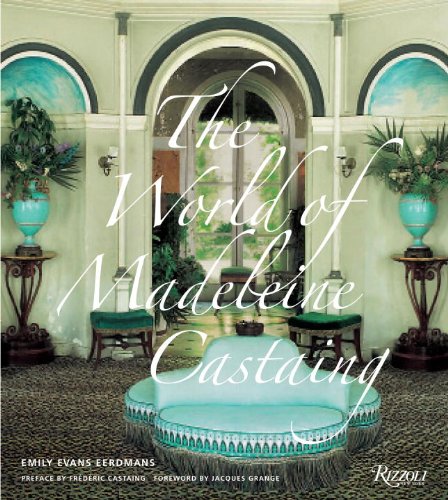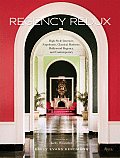 Lamp shades have always perplexed me and seldom do I get it right. Enter Toby Worthington, everybody's favorite blogosphere commentator, who kindly shared some rules of thumb.
Lamp shades have always perplexed me and seldom do I get it right. Enter Toby Worthington, everybody's favorite blogosphere commentator, who kindly shared some rules of thumb.Years ago while visiting Colefax & Fowler at 39 Brook Street, Mr. Worthington was granted permission to take measurements of their lamps and shades, which always struck him as perfectly proportioned.
Two things were apparent: the shape was always a gentle slope (not overly slanted or coolie tapered) and, even on the most refined porcelains, the material of the shade was plain off-white parchment.
You can find examples of this in Roger Banks-Pye's sublime Interior Inspirations as seen in the top photo.

Above, a reasonably priced, silk-lined shade from Restoration Hardware in the English Barrel shape used on two different lamps, in Mr. Worthington's own living room, below. Cost: 60 dollars! However, he just alerted me that they are currently on sale. Click here to stock up... You can find examples of this in Roger Banks-Pye's sublime Interior Inspirations as seen in the top photo.


 Scale depends, as a rule, on the distance between bottom of lamp and the point where it meets the socket~a good proportion is to have the shade's base diameter equivalent to the distance between the lower part of the socket and the base of the lamp itself. Note that the Colefax shades tend to be less tall than their American counterparts.
Scale depends, as a rule, on the distance between bottom of lamp and the point where it meets the socket~a good proportion is to have the shade's base diameter equivalent to the distance between the lower part of the socket and the base of the lamp itself. Note that the Colefax shades tend to be less tall than their American counterparts. Another Roger Banks-Pye room with a shade very similar to Restoration Hardware's, although you can rest assured their client paid a lot more than 60 bucks.
Another Roger Banks-Pye room with a shade very similar to Restoration Hardware's, although you can rest assured their client paid a lot more than 60 bucks.Example: Shade with base diameter of 18 inches would have a sloped height of around 11 or 12 inches.
Mr. Worthington sagely reminds us that the formula changes a bit when fitting shades on to candlestick or columnar lamps - obviously a tall slender lamp would be overwhelmed by anything too large...
 I have a pair of these adjustable candlestick floor lamps by Bill Blass for Visual Comfort flanking my sofa. Luckily they came with these parchment shades, or else they'd probably still be naked. Click here to see the entire Bill Blass Visual Comfort line which is quite handsome.
I have a pair of these adjustable candlestick floor lamps by Bill Blass for Visual Comfort flanking my sofa. Luckily they came with these parchment shades, or else they'd probably still be naked. Click here to see the entire Bill Blass Visual Comfort line which is quite handsome. And finally Mr. Worthington shares this illustration of how to proportion the shade on a columnar lamp: Vaughan, Pembroke shape, cream card. It replaced an "old lady" shade of bell-shaped silk. Much smarter now.
And finally Mr. Worthington shares this illustration of how to proportion the shade on a columnar lamp: Vaughan, Pembroke shape, cream card. It replaced an "old lady" shade of bell-shaped silk. Much smarter now.






12 comments:
In my lampshade conundrum Toby sent me the same advice which I printed and put in a folder. Isn't it wonderful to have such great advice come your way? And Banks-Pye gets me every time. That top room is an all time favorite.
Patricia, I stole the top photo from you as I don't have my copy of the book handy! YES, it is fantastic to have such excellent advice generously AND candidly given - I love that Mr. Worthington does not mince words.
In the original edition of Decorating is Fun, Dorothy Draper gives very good illustrated instructions on lampshade proportions. I seem to have amalgamated both hers and Toby W's advice when I chose a large shade for a big urn-style lamp base. The result is magnificent, wish I could show you!
Be creative and explore those proportions / equations...expand one's vocabulary to include square, oval, hexagonal, smocked, wallpapered, painted, docopauged. Those rules need not / do not always apply. Call Lisa at Blanche Field in NYC.. now she is the gal de chic expert on all things lampshades. Have Fun!!
Oh the coolie shade in pale blue lacquered paper on a column or candlestick lampshade ala Albert Hadley - now he is a true American Decorator PRO!!!
Uh-oh. Bell-shaped silk is "old lady"?
I shall copy this and tuck it away for future reference. Thanks.
excuse me Ms. Emily - all these emails back and forth with "Toby" and YOU YOU YOU get to print pictures of his house first?????
I am livid!!!!
hehehehe
Toby - you owe me BIG time!!!!!!!
I want to be the one to show the ERMINE and the CHANDELIER!!!!!!!!
All this proportion stuff! I wonder if the ratio is the golden mean. That said, I think a lamp is like a lady who loves to wear hats. If it says "looking good" right back at you, it works.
My point was simply that there are so many god-awful lampshades out there, drawing rather too much attention to themselves when, in most cases, the lamp itself ought to take precedence. Do what you like, have pagodas, squares, coolies and the like. There's room for nearly everything. But bell-shaped lampshades are dreary and sadly ubiquitous, to be avoided like the plague.
Hope you have a minute to hop over and enter the give away at blog, "Architect Design" - he is giving away one of 3 lamps....
Love this post. Tips from Toby, always worthy.
pve
Nick Olsen is an old lady so I don't have a problem with the term.
However, to my eye, the above lampshades are the epitome of "old lady" and to borrow Toby's term, "god awful." Many lamps don't fall into such simple categorization, therefore it's not so easy to just dictate that X shade or Y shade is THE shade to use.
I find that decorating dictums are best ignored.
I think each lampshade should have something unique to say to its lamp. My favorite, here at home, would be equally or perhaps even more appropriately set in a house of ill repute.
Post a Comment